自动化控制英文缩写解释
自动化控制英文缩写解释

自动化控制英文缩写解释BAS:楼宇自控系统(Building Automation System)又称为建筑设备自动化系统,它是在综合运用自动控制、计算机、通信、传感器等技术的基础上,实现建筑物设备和实施的有效控制与管理,保证建筑设施的节能、高效、可靠、安全运行,满足广大使用者的需求。
OPC:是英文OLE for Process Control的缩写,意为过程控制中的对象嵌入技术,是一项工业技术规范与标准部件对象模块(COM, Component Object Model)分布部件对象模块(DCOM, Distributed Component Object Model)LON:全称为Local Operating Networks,即局部操作网络。
是由美国Echelon公司推出的,是目前最流行的现场总线之一。
LonWorks:是Echelon公司为支持LON总线的设计而开发的一整套完整的开发平台。
LonTalk:是LonWorks中使用的开放式通信协议,其最大特点是对ISO/OSI七层参考模型的完全支持。
LonMark: 是与Echelon公司无关的LonWorks用户标准化组织,按照LonMark设计规范设计的LonWorks产品均可非常容易地集成在一起。
BACnet:楼宇自动控制网络数据通讯协议(即: A Date Communication Protocol for Building Automation and Control Networks,简称《BACnet 协议》)BACnet标准=对象模型+应用层服务+网络层+多种局域网EIB:(European installation bus) 作为第一个专门应用于电气安装、房屋自动化和安全系统等领域的开放性标准,近年来在国内外场馆照明、智能家居、大范围电气控制等功能型建筑应用中获得巨大成功。
但EIB作为一个标准在普通民用建筑、暖通空调和安全技术等领域的推广并不成功。
自动化控制英文缩写解释
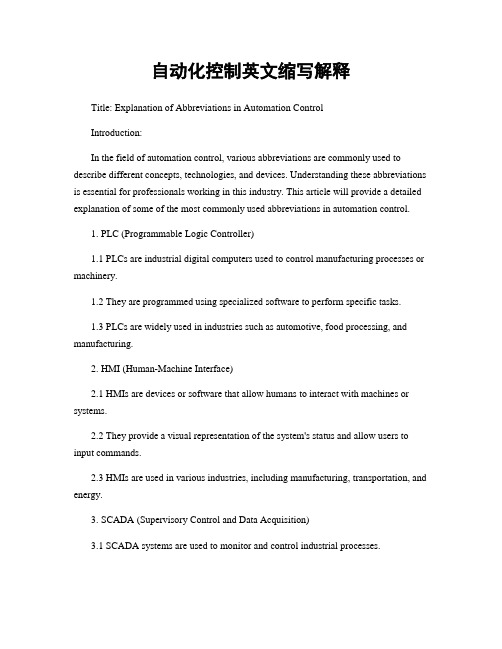
自动化控制英文缩写解释Title: Explanation of Abbreviations in Automation ControlIntroduction:In the field of automation control, various abbreviations are commonly used to describe different concepts, technologies, and devices. Understanding these abbreviations is essential for professionals working in this industry. This article will provide a detailed explanation of some of the most commonly used abbreviations in automation control.1. PLC (Programmable Logic Controller)1.1 PLCs are industrial digital computers used to control manufacturing processes or machinery.1.2 They are programmed using specialized software to perform specific tasks.1.3 PLCs are widely used in industries such as automotive, food processing, and manufacturing.2. HMI (Human-Machine Interface)2.1 HMIs are devices or software that allow humans to interact with machines or systems.2.2 They provide a visual representation of the system's status and allow users to input commands.2.3 HMIs are used in various industries, including manufacturing, transportation, and energy.3. SCADA (Supervisory Control and Data Acquisition)3.1 SCADA systems are used to monitor and control industrial processes.3.2 They collect data from sensors and other devices and display it to operators in real-time.3.3 SCADA systems are used in industries such as oil and gas, water treatment, and power generation.4. DCS (Distributed Control System)4.1 DCSs are control systems used to control multiple processes or machines from a central location.4.2 They consist of multiple controllers distributed throughout a plant or facility.4.3 DCSs are commonly used in industries such as chemical processing, power generation, and pharmaceuticals.5. PID (Proportional-Integral-Derivative) Controller5.1 PID controllers are used to regulate process variables such as temperature, pressure, or flow.5.2 They use proportional, integral, and derivative control actions to maintain a desired setpoint.5.3 PID controllers are widely used in industries such as HVAC, robotics, and automotive manufacturing.In conclusion, understanding the abbreviations commonly used in automation control is essential for professionals working in this field. PLCs, HMIs, SCADA systems, DCSs, and PID controllers are just a few of the abbreviations that professionals in this industry encounter on a daily basis. By familiarizing themselves with these abbreviations and their meanings, professionals can effectively communicate and collaborate with their colleagues in the field of automation control.。
自动化控制英文缩写解释
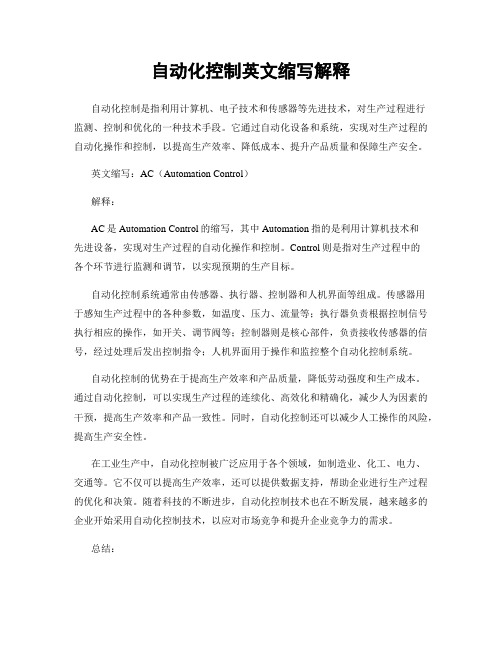
自动化控制英文缩写解释自动化控制是指利用计算机、电子技术和传感器等先进技术,对生产过程进行监测、控制和优化的一种技术手段。
它通过自动化设备和系统,实现对生产过程的自动化操作和控制,以提高生产效率、降低成本、提升产品质量和保障生产安全。
英文缩写:AC(Automation Control)解释:AC是Automation Control的缩写,其中Automation指的是利用计算机技术和先进设备,实现对生产过程的自动化操作和控制。
Control则是指对生产过程中的各个环节进行监测和调节,以实现预期的生产目标。
自动化控制系统通常由传感器、执行器、控制器和人机界面等组成。
传感器用于感知生产过程中的各种参数,如温度、压力、流量等;执行器负责根据控制信号执行相应的操作,如开关、调节阀等;控制器则是核心部件,负责接收传感器的信号,经过处理后发出控制指令;人机界面用于操作和监控整个自动化控制系统。
自动化控制的优势在于提高生产效率和产品质量,降低劳动强度和生产成本。
通过自动化控制,可以实现生产过程的连续化、高效化和精确化,减少人为因素的干预,提高生产效率和产品一致性。
同时,自动化控制还可以减少人工操作的风险,提高生产安全性。
在工业生产中,自动化控制被广泛应用于各个领域,如制造业、化工、电力、交通等。
它不仅可以提高生产效率,还可以提供数据支持,帮助企业进行生产过程的优化和决策。
随着科技的不断进步,自动化控制技术也在不断发展,越来越多的企业开始采用自动化控制技术,以应对市场竞争和提升企业竞争力的需求。
总结:自动化控制(Automation Control)是利用计算机、电子技术和传感器等技术手段,对生产过程进行监测、控制和优化的一种技术。
它通过自动化设备和系统,实现对生产过程的自动化操作和控制,以提高生产效率、降低成本、提升产品质量和保障生产安全。
AC是Automation Control的缩写,代表了自动化控制的英文表达。
自动化常用英文缩写

自动化常用英文缩写自动化(Automation)是指利用计算机、机器人和其他自动化设备来代替人力完成工作的过程。
在自动化领域中,人们往往使用缩写词来简化和快速传达信息。
以下是一些自动化常用英文缩写及其解释:1. PLC - Programmable Logic Controller(可编程逻辑控制器)PLC是一种用于控制和监控自动化系统的计算机控制器。
它可以接收输入信号,进行逻辑运算,然后输出控制信号,从而实现自动化控制。
2. SCADA - Supervisory Control and Data Acquisition(监控与数据采集)SCADA系统用于监控和控制工业过程中的设备和参数。
它可以实时采集数据并显示在操作员界面上,同时还能进行报警和记录。
3. HMI - Human Machine Interface(人机界面)HMI是一种用于人机交互的设备,通常是触摸屏或者显示屏。
它通过图形化界面向操作员展示自动化系统的状态,并提供操作和控制功能。
4. DCS - Distributed Control System(分布式控制系统)DCS是一种用于控制和监控大型工业过程的系统。
它由多个分布式控制器组成,可以实现分布式控制和集中管理。
5. MES - Manufacturing Execution System(创造执行系统)MES是一种用于管理和控制创造过程的系统。
它可以跟踪生产进度、采集生产数据,并提供实时的生产监控和报告。
6. CNC - Computer Numerical Control(计算机数控)CNC是一种用于控制机械设备的技术。
它通过计算机程序控制设备的运动和操作,实现高精度和自动化加工。
7. RFID - Radio Frequency Identification(射频识别)RFID是一种用于识别和跟踪物体的技术。
它使用无线电信号来读取和写入存储在RFID标签中的信息,实现自动化的物流管理和库存控制。
自动化控制英文缩写解释
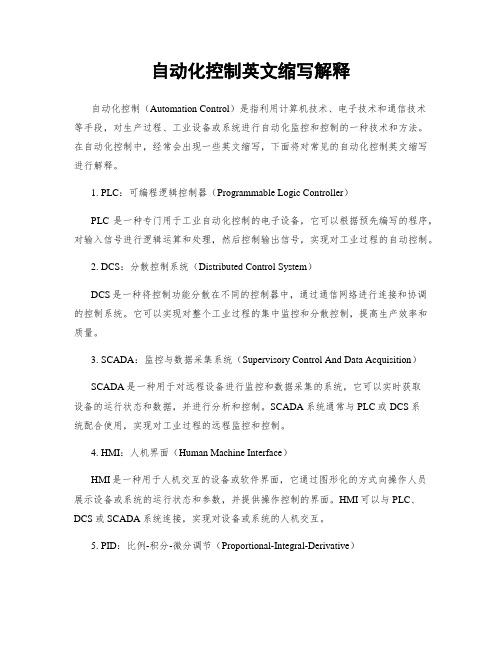
自动化控制英文缩写解释自动化控制(Automation Control)是指利用计算机技术、电子技术和通信技术等手段,对生产过程、工业设备或系统进行自动化监控和控制的一种技术和方法。
在自动化控制中,经常会出现一些英文缩写,下面将对常见的自动化控制英文缩写进行解释。
1. PLC:可编程逻辑控制器(Programmable Logic Controller)PLC是一种专门用于工业自动化控制的电子设备,它可以根据预先编写的程序,对输入信号进行逻辑运算和处理,然后控制输出信号,实现对工业过程的自动控制。
2. DCS:分散控制系统(Distributed Control System)DCS是一种将控制功能分散在不同的控制器中,通过通信网络进行连接和协调的控制系统。
它可以实现对整个工业过程的集中监控和分散控制,提高生产效率和质量。
3. SCADA:监控与数据采集系统(Supervisory Control And Data Acquisition)SCADA是一种用于对远程设备进行监控和数据采集的系统,它可以实时获取设备的运行状态和数据,并进行分析和控制。
SCADA系统通常与PLC或DCS系统配合使用,实现对工业过程的远程监控和控制。
4. HMI:人机界面(Human Machine Interface)HMI是一种用于人机交互的设备或软件界面,它通过图形化的方式向操作人员展示设备或系统的运行状态和参数,并提供操作控制的界面。
HMI可以与PLC、DCS或SCADA系统连接,实现对设备或系统的人机交互。
5. PID:比例-积分-微分调节(Proportional-Integral-Derivative)PID是一种常用的控制算法,它根据设定值和反馈值之间的差异,计算出控制量的调整量。
PID控制器可以根据比例、积分和微分三个参数的设定,实现对系统的稳定控制和动态响应。
6. I/O:输入/输出(Input/Output)I/O是指计算机系统中用于与外部设备进行数据交换的接口和通道。
自动化常用英文缩写
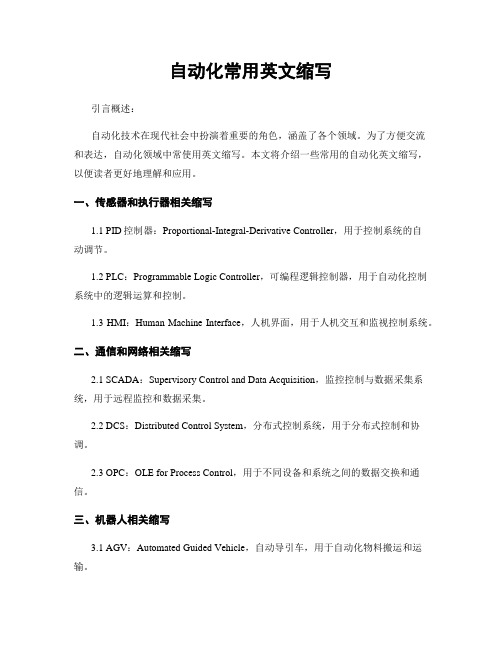
自动化常用英文缩写引言概述:自动化技术在现代社会中扮演着重要的角色,涵盖了各个领域。
为了方便交流和表达,自动化领域中常使用英文缩写。
本文将介绍一些常用的自动化英文缩写,以便读者更好地理解和应用。
一、传感器和执行器相关缩写1.1 PID控制器:Proportional-Integral-Derivative Controller,用于控制系统的自动调节。
1.2 PLC:Programmable Logic Controller,可编程逻辑控制器,用于自动化控制系统中的逻辑运算和控制。
1.3 HMI:Human Machine Interface,人机界面,用于人机交互和监视控制系统。
二、通信和网络相关缩写2.1 SCADA:Supervisory Control and Data Acquisition,监控控制与数据采集系统,用于远程监控和数据采集。
2.2 DCS:Distributed Control System,分布式控制系统,用于分布式控制和协调。
2.3 OPC:OLE for Process Control,用于不同设备和系统之间的数据交换和通信。
三、机器人相关缩写3.1 AGV:Automated Guided Vehicle,自动导引车,用于自动化物料搬运和运输。
3.2 AI:Artificial Intelligence,人工智能,用于机器人的智能决策和学习能力。
3.3 ROS:Robot Operating System,机器人操作系统,用于机器人软件开发和控制。
四、工业自动化相关缩写4.1 MES:Manufacturing Execution System,制造执行系统,用于生产计划和过程控制。
4.2 ERP:Enterprise Resource Planning,企业资源计划,用于企业资源管理和集成。
4.3 SCARA:Selective Compliance Assembly Robot Arm,选择性约束装配机器人,用于装配和加工操作。
自动化常用英文缩写
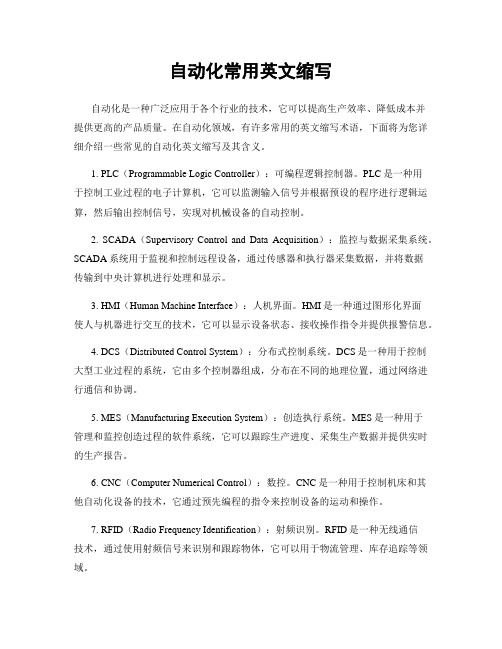
自动化常用英文缩写自动化是一种广泛应用于各个行业的技术,它可以提高生产效率、降低成本并提供更高的产品质量。
在自动化领域,有许多常用的英文缩写术语,下面将为您详细介绍一些常见的自动化英文缩写及其含义。
1. PLC(Programmable Logic Controller):可编程逻辑控制器。
PLC是一种用于控制工业过程的电子计算机,它可以监测输入信号并根据预设的程序进行逻辑运算,然后输出控制信号,实现对机械设备的自动控制。
2. SCADA(Supervisory Control and Data Acquisition):监控与数据采集系统。
SCADA系统用于监视和控制远程设备,通过传感器和执行器采集数据,并将数据传输到中央计算机进行处理和显示。
3. HMI(Human Machine Interface):人机界面。
HMI是一种通过图形化界面使人与机器进行交互的技术,它可以显示设备状态、接收操作指令并提供报警信息。
4. DCS(Distributed Control System):分布式控制系统。
DCS是一种用于控制大型工业过程的系统,它由多个控制器组成,分布在不同的地理位置,通过网络进行通信和协调。
5. MES(Manufacturing Execution System):创造执行系统。
MES是一种用于管理和监控创造过程的软件系统,它可以跟踪生产进度、采集生产数据并提供实时的生产报告。
6. CNC(Computer Numerical Control):数控。
CNC是一种用于控制机床和其他自动化设备的技术,它通过预先编程的指令来控制设备的运动和操作。
7. RFID(Radio Frequency Identification):射频识别。
RFID是一种无线通信技术,通过使用射频信号来识别和跟踪物体,它可以用于物流管理、库存追踪等领域。
8. AI(Artificial Intelligence):人工智能。
自动化控制英文缩写解释
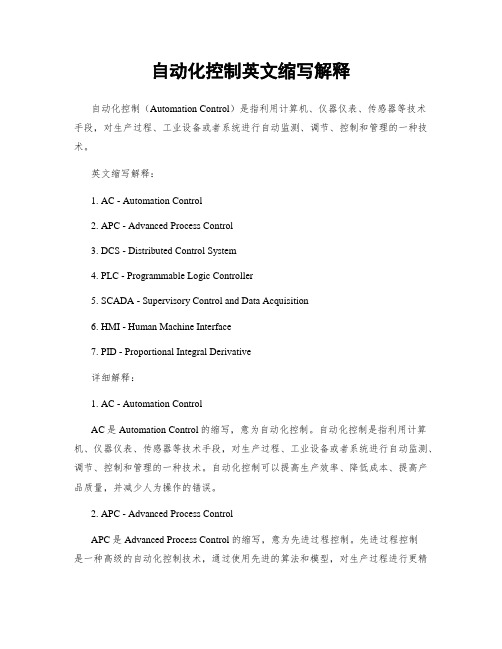
自动化控制英文缩写解释自动化控制(Automation Control)是指利用计算机、仪器仪表、传感器等技术手段,对生产过程、工业设备或者系统进行自动监测、调节、控制和管理的一种技术。
英文缩写解释:1. AC - Automation Control2. APC - Advanced Process Control3. DCS - Distributed Control System4. PLC - Programmable Logic Controller5. SCADA - Supervisory Control and Data Acquisition6. HMI - Human Machine Interface7. PID - Proportional Integral Derivative详细解释:1. AC - Automation ControlAC是Automation Control的缩写,意为自动化控制。
自动化控制是指利用计算机、仪器仪表、传感器等技术手段,对生产过程、工业设备或者系统进行自动监测、调节、控制和管理的一种技术。
自动化控制可以提高生产效率、降低成本、提高产品质量,并减少人为操作的错误。
2. APC - Advanced Process ControlAPC是Advanced Process Control的缩写,意为先进过程控制。
先进过程控制是一种高级的自动化控制技术,通过使用先进的算法和模型,对生产过程进行更精确的控制和优化。
它可以提高生产过程的稳定性、可靠性和效率,减少能源和原材料的消耗,并优化产品质量。
3. DCS - Distributed Control SystemDCS是Distributed Control System的缩写,意为分布式控制系统。
分布式控制系统是一种将控制功能分布在多个控制器中的系统,每一个控制器负责一个或者多个设备或者过程的控制。
自动化常用英文缩写
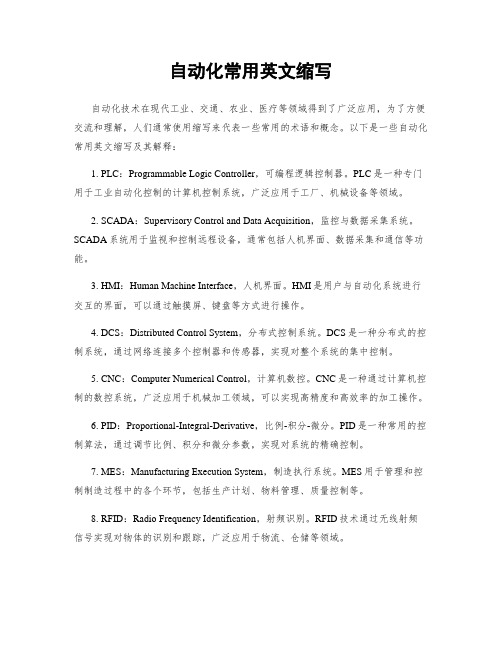
自动化常用英文缩写自动化技术在现代工业、交通、农业、医疗等领域得到了广泛应用,为了方便交流和理解,人们通常使用缩写来代表一些常用的术语和概念。
以下是一些自动化常用英文缩写及其解释:1. PLC:Programmable Logic Controller,可编程逻辑控制器。
PLC是一种专门用于工业自动化控制的计算机控制系统,广泛应用于工厂、机械设备等领域。
2. SCADA:Supervisory Control and Data Acquisition,监控与数据采集系统。
SCADA系统用于监视和控制远程设备,通常包括人机界面、数据采集和通信等功能。
3. HMI:Human Machine Interface,人机界面。
HMI是用户与自动化系统进行交互的界面,可以通过触摸屏、键盘等方式进行操作。
4. DCS:Distributed Control System,分布式控制系统。
DCS是一种分布式的控制系统,通过网络连接多个控制器和传感器,实现对整个系统的集中控制。
5. CNC:Computer Numerical Control,计算机数控。
CNC是一种通过计算机控制的数控系统,广泛应用于机械加工领域,可以实现高精度和高效率的加工操作。
6. PID:Proportional-Integral-Derivative,比例-积分-微分。
PID是一种常用的控制算法,通过调节比例、积分和微分参数,实现对系统的精确控制。
7. MES:Manufacturing Execution System,制造执行系统。
MES用于管理和控制制造过程中的各个环节,包括生产计划、物料管理、质量控制等。
8. RFID:Radio Frequency Identification,射频识别。
RFID技术通过无线射频信号实现对物体的识别和跟踪,广泛应用于物流、仓储等领域。
9. IoT:Internet of Things,物联网。
自动化常用英文缩写
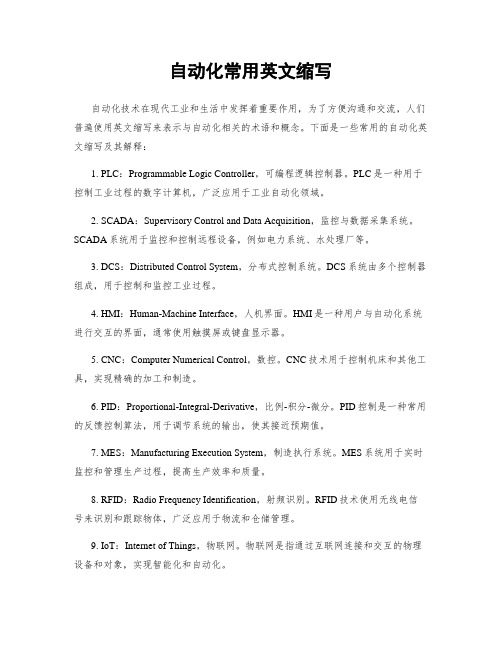
自动化常用英文缩写自动化技术在现代工业和生活中发挥着重要作用,为了方便沟通和交流,人们普遍使用英文缩写来表示与自动化相关的术语和概念。
下面是一些常用的自动化英文缩写及其解释:1. PLC:Programmable Logic Controller,可编程逻辑控制器。
PLC是一种用于控制工业过程的数字计算机,广泛应用于工业自动化领域。
2. SCADA:Supervisory Control and Data Acquisition,监控与数据采集系统。
SCADA系统用于监控和控制远程设备,例如电力系统、水处理厂等。
3. DCS:Distributed Control System,分布式控制系统。
DCS系统由多个控制器组成,用于控制和监控工业过程。
4. HMI:Human-Machine Interface,人机界面。
HMI是一种用户与自动化系统进行交互的界面,通常使用触摸屏或键盘显示器。
5. CNC:Computer Numerical Control,数控。
CNC技术用于控制机床和其他工具,实现精确的加工和制造。
6. PID:Proportional-Integral-Derivative,比例-积分-微分。
PID控制是一种常用的反馈控制算法,用于调节系统的输出,使其接近预期值。
7. MES:Manufacturing Execution System,制造执行系统。
MES系统用于实时监控和管理生产过程,提高生产效率和质量。
8. RFID:Radio Frequency Identification,射频识别。
RFID技术使用无线电信号来识别和跟踪物体,广泛应用于物流和仓储管理。
9. IoT:Internet of Things,物联网。
物联网是指通过互联网连接和交互的物理设备和对象,实现智能化和自动化。
10. AI:Artificial Intelligence,人工智能。
AI技术用于模拟和仿真人类智能,实现自动化决策和任务执行。
自动化控制英文缩写解释
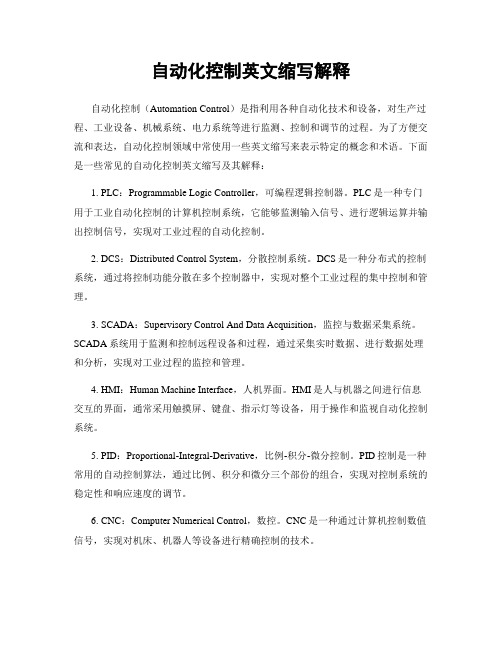
自动化控制英文缩写解释自动化控制(Automation Control)是指利用各种自动化技术和设备,对生产过程、工业设备、机械系统、电力系统等进行监测、控制和调节的过程。
为了方便交流和表达,自动化控制领域中常使用一些英文缩写来表示特定的概念和术语。
下面是一些常见的自动化控制英文缩写及其解释:1. PLC:Programmable Logic Controller,可编程逻辑控制器。
PLC是一种专门用于工业自动化控制的计算机控制系统,它能够监测输入信号、进行逻辑运算并输出控制信号,实现对工业过程的自动化控制。
2. DCS:Distributed Control System,分散控制系统。
DCS是一种分布式的控制系统,通过将控制功能分散在多个控制器中,实现对整个工业过程的集中控制和管理。
3. SCADA:Supervisory Control And Data Acquisition,监控与数据采集系统。
SCADA系统用于监测和控制远程设备和过程,通过采集实时数据、进行数据处理和分析,实现对工业过程的监控和管理。
4. HMI:Human Machine Interface,人机界面。
HMI是人与机器之间进行信息交互的界面,通常采用触摸屏、键盘、指示灯等设备,用于操作和监视自动化控制系统。
5. PID:Proportional-Integral-Derivative,比例-积分-微分控制。
PID控制是一种常用的自动控制算法,通过比例、积分和微分三个部份的组合,实现对控制系统的稳定性和响应速度的调节。
6. CNC:Computer Numerical Control,数控。
CNC是一种通过计算机控制数值信号,实现对机床、机器人等设备进行精确控制的技术。
7. MES:Manufacturing Execution System,创造执行系统。
MES系统用于管理和控制创造过程中的各个环节,包括计划排程、生产监控、质量管理等,实现对创造过程的优化和管理。
自动化常用英文缩写
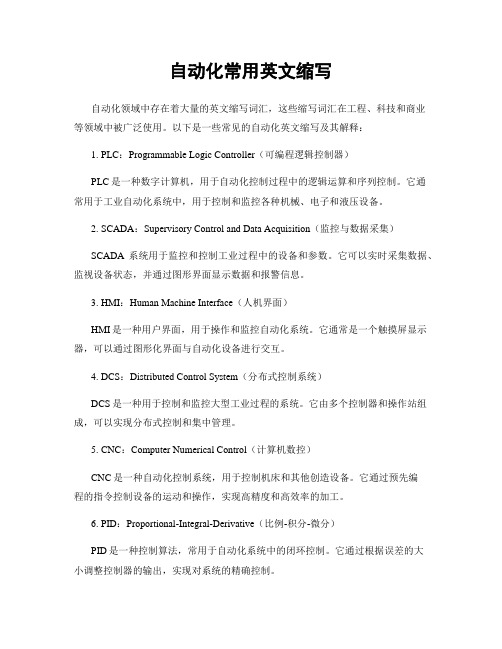
自动化常用英文缩写自动化领域中存在着大量的英文缩写词汇,这些缩写词汇在工程、科技和商业等领域中被广泛使用。
以下是一些常见的自动化英文缩写及其解释:1. PLC:Programmable Logic Controller(可编程逻辑控制器)PLC是一种数字计算机,用于自动化控制过程中的逻辑运算和序列控制。
它通常用于工业自动化系统中,用于控制和监控各种机械、电子和液压设备。
2. SCADA:Supervisory Control and Data Acquisition(监控与数据采集)SCADA系统用于监控和控制工业过程中的设备和参数。
它可以实时采集数据、监视设备状态,并通过图形界面显示数据和报警信息。
3. HMI:Human Machine Interface(人机界面)HMI是一种用户界面,用于操作和监控自动化系统。
它通常是一个触摸屏显示器,可以通过图形化界面与自动化设备进行交互。
4. DCS:Distributed Control System(分布式控制系统)DCS是一种用于控制和监控大型工业过程的系统。
它由多个控制器和操作站组成,可以实现分布式控制和集中管理。
5. CNC:Computer Numerical Control(计算机数控)CNC是一种自动化控制系统,用于控制机床和其他创造设备。
它通过预先编程的指令控制设备的运动和操作,实现高精度和高效率的加工。
6. PID:Proportional-Integral-Derivative(比例-积分-微分)PID是一种控制算法,常用于自动化系统中的闭环控制。
它通过根据误差的大小调整控制器的输出,实现对系统的精确控制。
7. MES:Manufacturing Execution System(创造执行系统)MES是一种用于管理和控制创造过程的系统。
它可以跟踪和监控生产进程、采集和分析数据,并协调各个生产环节,提高生产效率和质量。
8. RFID:Radio Frequency Identification(射频识别)RFID是一种无线通信技术,用于识别和跟踪物体。
自动化控制英文缩写解释
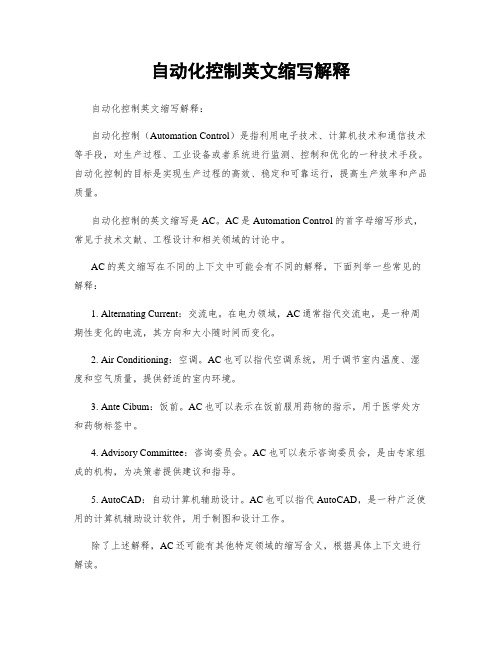
自动化控制英文缩写解释自动化控制英文缩写解释:自动化控制(Automation Control)是指利用电子技术、计算机技术和通信技术等手段,对生产过程、工业设备或者系统进行监测、控制和优化的一种技术手段。
自动化控制的目标是实现生产过程的高效、稳定和可靠运行,提高生产效率和产品质量。
自动化控制的英文缩写是AC。
AC是Automation Control的首字母缩写形式,常见于技术文献、工程设计和相关领域的讨论中。
AC的英文缩写在不同的上下文中可能会有不同的解释,下面列举一些常见的解释:1. Alternating Current:交流电。
在电力领域,AC通常指代交流电,是一种周期性变化的电流,其方向和大小随时间而变化。
2. Air Conditioning:空调。
AC也可以指代空调系统,用于调节室内温度、湿度和空气质量,提供舒适的室内环境。
3. Ante Cibum:饭前。
AC也可以表示在饭前服用药物的指示,用于医学处方和药物标签中。
4. Advisory Committee:咨询委员会。
AC也可以表示咨询委员会,是由专家组成的机构,为决策者提供建议和指导。
5. AutoCAD:自动计算机辅助设计。
AC也可以指代AutoCAD,是一种广泛使用的计算机辅助设计软件,用于制图和设计工作。
除了上述解释,AC还可能有其他特定领域的缩写含义,根据具体上下文进行解读。
总结起来,自动化控制的英文缩写AC在不同的领域和上下文中可能有不同的解释,常见的包括Alternating Current、Air Conditioning、Ante Cibum、Advisory Committee和AutoCAD等。
具体的解释需要根据具体上下文来确定。
自动化控制英文缩写解释
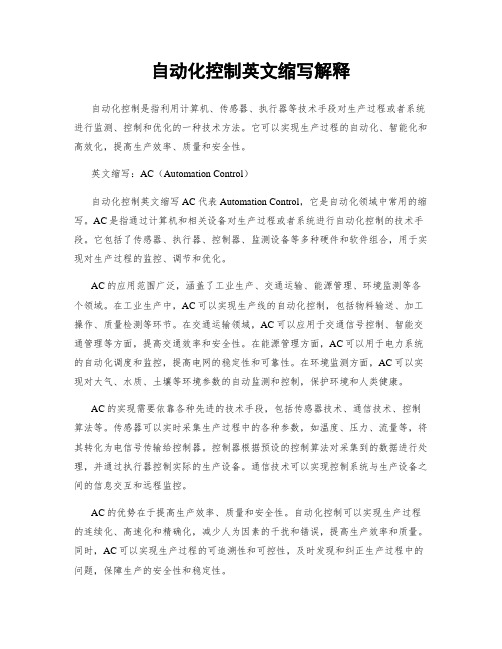
自动化控制英文缩写解释自动化控制是指利用计算机、传感器、执行器等技术手段对生产过程或者系统进行监测、控制和优化的一种技术方法。
它可以实现生产过程的自动化、智能化和高效化,提高生产效率、质量和安全性。
英文缩写:AC(Automation Control)自动化控制英文缩写AC代表Automation Control,它是自动化领域中常用的缩写。
AC是指通过计算机和相关设备对生产过程或者系统进行自动化控制的技术手段。
它包括了传感器、执行器、控制器、监测设备等多种硬件和软件组合,用于实现对生产过程的监控、调节和优化。
AC的应用范围广泛,涵盖了工业生产、交通运输、能源管理、环境监测等各个领域。
在工业生产中,AC可以实现生产线的自动化控制,包括物料输送、加工操作、质量检测等环节。
在交通运输领域,AC可以应用于交通信号控制、智能交通管理等方面,提高交通效率和安全性。
在能源管理方面,AC可以用于电力系统的自动化调度和监控,提高电网的稳定性和可靠性。
在环境监测方面,AC可以实现对大气、水质、土壤等环境参数的自动监测和控制,保护环境和人类健康。
AC的实现需要依靠各种先进的技术手段,包括传感器技术、通信技术、控制算法等。
传感器可以实时采集生产过程中的各种参数,如温度、压力、流量等,将其转化为电信号传输给控制器。
控制器根据预设的控制算法对采集到的数据进行处理,并通过执行器控制实际的生产设备。
通信技术可以实现控制系统与生产设备之间的信息交互和远程监控。
AC的优势在于提高生产效率、质量和安全性。
自动化控制可以实现生产过程的连续化、高速化和精确化,减少人为因素的干扰和错误,提高生产效率和质量。
同时,AC可以实现生产过程的可追溯性和可控性,及时发现和纠正生产过程中的问题,保障生产的安全性和稳定性。
总结起来,自动化控制(Automation Control)是利用计算机、传感器、执行器等技术手段对生产过程或者系统进行监测、控制和优化的一种技术方法。
自动化常用英文缩写

自动化常用英文缩写引言概述:在自动化领域中,常常出现各种英文缩写词汇,这些缩写词汇在技术交流和文档撰写中起到了重要的作用。
了解这些常用的英文缩写词汇,可以帮助我们更好地理解和应用自动化技术。
本文将介绍一些常用的自动化英文缩写,并详细解释其含义和用途。
一、PLC(Programmable Logic Controller)1.1 硬件层面:PLC是一种专门用于工业自动化控制的可编程逻辑控制器。
它由CPU、存储器、输入/输出模块等组成,可用于控制各种工业过程。
1.2 软件层面:PLC的软件通常由Ladder Diagram(梯形图)或者Structured Text(结构化文本)编写,用于实现各种逻辑控制功能。
1.3 应用领域:PLC广泛应用于工业自动化领域,如生产线控制、机器人控制、电力系统控制等。
二、SCADA(Supervisory Control and Data Acquisition)2.1 监控:SCADA系统用于监控和控制工业过程中的设备和参数。
它可以实时采集数据、显示设备状态,并进行报警和故障处理。
2.2 控制:SCADA系统可以通过远程操作实现对设备的控制,如开关控制、调节参数等。
2.3 数据采集:SCADA系统可以采集各种传感器和仪表的数据,并进行存储和分析,为工程师提供决策依据。
三、HMI(Human Machine Interface)3.1 人机交互:HMI是人与机器之间进行信息交流和操作的界面。
它通常由触摸屏、按钮、指示灯等组成,用于显示设备状态、接收操作指令。
3.2 数据可视化:HMI可以将采集到的数据以图表、曲线等形式直观地展示给操作人员,帮助他们更好地理解设备运行情况。
3.3 报警和故障处理:HMI可以及时报警并显示故障信息,方便工程师进行故障排查和处理。
四、DCS(Distributed Control System)4.1 分布式控制:DCS是一种将控制功能分布在多个控制节点上的系统。
自动化控制英文缩写解释
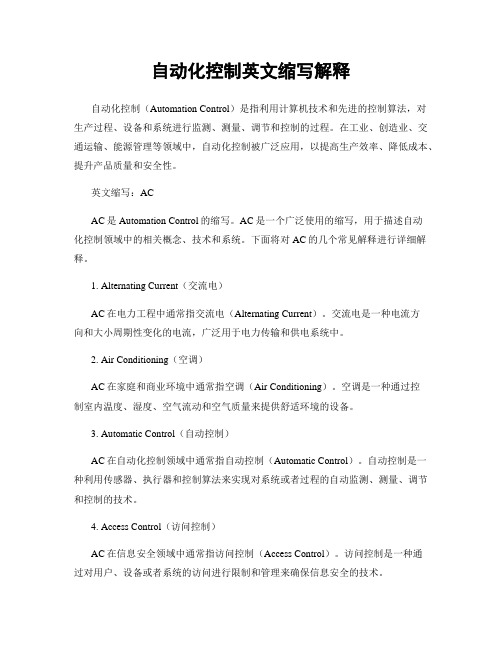
自动化控制英文缩写解释自动化控制(Automation Control)是指利用计算机技术和先进的控制算法,对生产过程、设备和系统进行监测、测量、调节和控制的过程。
在工业、创造业、交通运输、能源管理等领域中,自动化控制被广泛应用,以提高生产效率、降低成本、提升产品质量和安全性。
英文缩写:ACAC是Automation Control的缩写。
AC是一个广泛使用的缩写,用于描述自动化控制领域中的相关概念、技术和系统。
下面将对AC的几个常见解释进行详细解释。
1. Alternating Current(交流电)AC在电力工程中通常指交流电(Alternating Current)。
交流电是一种电流方向和大小周期性变化的电流,广泛用于电力传输和供电系统中。
2. Air Conditioning(空调)AC在家庭和商业环境中通常指空调(Air Conditioning)。
空调是一种通过控制室内温度、湿度、空气流动和空气质量来提供舒适环境的设备。
3. Automatic Control(自动控制)AC在自动化控制领域中通常指自动控制(Automatic Control)。
自动控制是一种利用传感器、执行器和控制算法来实现对系统或者过程的自动监测、测量、调节和控制的技术。
4. Access Control(访问控制)AC在信息安全领域中通常指访问控制(Access Control)。
访问控制是一种通过对用户、设备或者系统的访问进行限制和管理来确保信息安全的技术。
5. Active Control(主动控制)AC在结构工程和振动控制领域中通常指主动控制(Active Control)。
主动控制是一种通过在结构或者系统中引入主动装置,以减小振动、噪声或者其他不良影响的技术。
总结:自动化控制英文缩写AC可以代表多个概念和领域,包括交流电、空调、自动控制、访问控制和主动控制等。
具体使用时,需要根据上下文来确定AC的具体含义。
自动化控制英文缩写解释
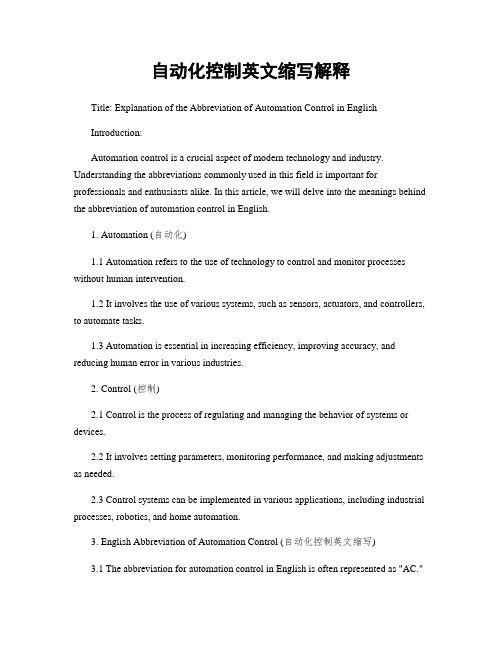
自动化控制英文缩写解释Title: Explanation of the Abbreviation of Automation Control in EnglishIntroduction:Automation control is a crucial aspect of modern technology and industry. Understanding the abbreviations commonly used in this field is important for professionals and enthusiasts alike. In this article, we will delve into the meanings behind the abbreviation of automation control in English.1. Automation (自动化)1.1 Automation refers to the use of technology to control and monitor processes without human intervention.1.2 It involves the use of various systems, such as sensors, actuators, and controllers, to automate tasks.1.3 Automation is essential in increasing efficiency, improving accuracy, and reducing human error in various industries.2. Control (控制)2.1 Control is the process of regulating and managing the behavior of systems or devices.2.2 It involves setting parameters, monitoring performance, and making adjustments as needed.2.3 Control systems can be implemented in various applications, including industrial processes, robotics, and home automation.3. English Abbreviation of Automation Control (自动化控制英文缩写)3.1 The abbreviation for automation control in English is often represented as "AC."3.2 This abbreviation is commonly used in technical documentation, discussions, and presentations.3.3 Understanding this abbreviation is crucial for effective communication within the automation control industry.4. Importance of Understanding Abbreviations in Automation Control (了解自动化控制缩写的重要性)4.1 Abbreviations help streamline communication and facilitate quick understanding.4.2 Professionals in the automation control industry often use abbreviations to save time and space.4.3 Familiarity with abbreviations enhances efficiency and clarity in technical discussions and documentation.5. Conclusion:In conclusion, understanding the abbreviations used in automation control in English is essential for professionals and enthusiasts in the field. By grasping the meanings behind abbreviations such as "AC," individuals can communicate effectively and efficiently within the industry. As technology continues to advance, staying informed about abbreviations in automation control will remain crucial for success in this rapidly evolving field.。
自动化控制英文缩写解释
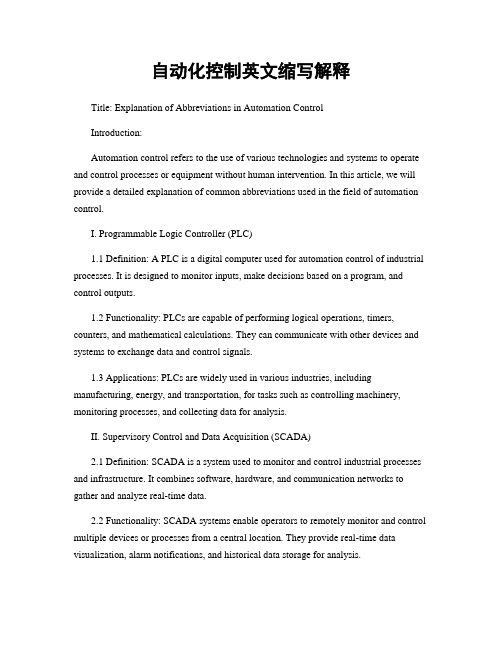
自动化控制英文缩写解释Title: Explanation of Abbreviations in Automation ControlIntroduction:Automation control refers to the use of various technologies and systems to operate and control processes or equipment without human intervention. In this article, we will provide a detailed explanation of common abbreviations used in the field of automation control.I. Programmable Logic Controller (PLC)1.1 Definition: A PLC is a digital computer used for automation control of industrial processes. It is designed to monitor inputs, make decisions based on a program, and control outputs.1.2 Functionality: PLCs are capable of performing logical operations, timers, counters, and mathematical calculations. They can communicate with other devices and systems to exchange data and control signals.1.3 Applications: PLCs are widely used in various industries, including manufacturing, energy, and transportation, for tasks such as controlling machinery, monitoring processes, and collecting data for analysis.II. Supervisory Control and Data Acquisition (SCADA)2.1 Definition: SCADA is a system used to monitor and control industrial processes and infrastructure. It combines software, hardware, and communication networks to gather and analyze real-time data.2.2 Functionality: SCADA systems enable operators to remotely monitor and control multiple devices or processes from a central location. They provide real-time data visualization, alarm notifications, and historical data storage for analysis.2.3 Applications: SCADA systems are commonly used in industries such as oil and gas, water and wastewater management, and power generation. They are essential for monitoring and controlling complex processes and ensuring operational efficiency.III. Distributed Control System (DCS)3.1 Definition: A DCS is a control system used to manage and control complex processes or manufacturing operations. It consists of multiple control units distributed throughout a plant or facility.3.2 Functionality: DCSs provide centralized control and monitoring capabilities for various subsystems or processes. They enable real-time data acquisition, process optimization, and coordination of different control loops.3.3 Applications: DCSs are extensively used in industries such as chemical, petrochemical, and power generation. They are ideal for managing large-scale processes that require precise control and coordination.IV. Human-Machine Interface (HMI)4.1 Definition: An HMI is a graphical interface that allows operators to interact with automation systems. It provides a visual representation of the process or equipment and enables control and monitoring.4.2 Functionality: HMIs enable operators to monitor real-time data, control equipment, and respond to alarms or abnormal situations. They often include features such as touchscreens, buttons, and indicators for intuitive operation.4.3 Applications: HMIs are used in various industries, including manufacturing, energy, and transportation. They play a crucial role in facilitating human interaction with automation systems and ensuring efficient operation.V. Internet of Things (IoT)5.1 Definition: IoT refers to the network of physical devices, vehicles, and other objects embedded with sensors, software, and connectivity. These devices can collect and exchange data, enabling automation and remote control.5.2 Functionality: IoT enables the integration of physical devices with digital systems, allowing for remote monitoring, control, and data analysis. It enables automation, predictive maintenance, and optimization of processes.5.3 Applications: IoT has applications in various sectors, including smart homes, industrial automation, and smart cities. It revolutionizes automation control by connecting devices and systems for improved efficiency and productivity.Conclusion:In the field of automation control, understanding the abbreviations used is essential for effective communication and comprehension. This article has provided a comprehensive explanation of common abbreviations, including PLC, SCADA, DCS, HMI, and IoT. By familiarizing yourself with these terms, you will be better equipped to navigate the world of automation control.。
自动化控制英文缩写解释
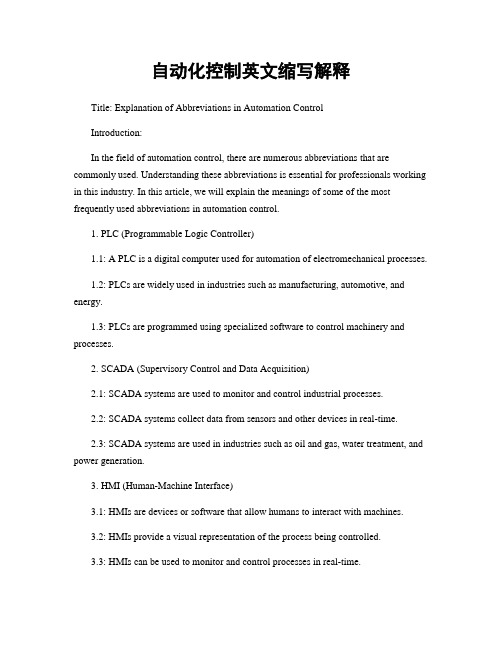
自动化控制英文缩写解释Title: Explanation of Abbreviations in Automation ControlIntroduction:In the field of automation control, there are numerous abbreviations that are commonly used. Understanding these abbreviations is essential for professionals working in this industry. In this article, we will explain the meanings of some of the most frequently used abbreviations in automation control.1. PLC (Programmable Logic Controller)1.1: A PLC is a digital computer used for automation of electromechanical processes.1.2: PLCs are widely used in industries such as manufacturing, automotive, and energy.1.3: PLCs are programmed using specialized software to control machinery and processes.2. SCADA (Supervisory Control and Data Acquisition)2.1: SCADA systems are used to monitor and control industrial processes.2.2: SCADA systems collect data from sensors and other devices in real-time.2.3: SCADA systems are used in industries such as oil and gas, water treatment, and power generation.3. HMI (Human-Machine Interface)3.1: HMIs are devices or software that allow humans to interact with machines.3.2: HMIs provide a visual representation of the process being controlled.3.3: HMIs can be used to monitor and control processes in real-time.4. DCS (Distributed Control System)4.1: DCSs are used to control processes in industries such as chemical, pharmaceutical, and food processing.4.2: DCSs consist of multiple control units distributed throughout a plant.4.3: DCSs are designed for high reliability and redundancy to ensure continuous operation.5. PID (Proportional-Integral-Derivative)5.1: PID controllers are used to regulate processes by adjusting the control output based on the error signal.5.2: PID controllers are commonly used in temperature, pressure, and flow control systems.5.3: PID controllers can be tuned to optimize performance and stability of the controlled process.Conclusion:Understanding the abbreviations used in automation control is crucial for professionals in this field. The abbreviations mentioned in this article are just a few of the many that are commonly used. By familiarizing yourself with these abbreviations, you will be better equipped to work in the field of automation control.。
自动化常用英文缩写

自动化常用英文缩写自动化是现代工业和科技领域中的一个重要领域,涉及到许多专业术语和常用英文缩写。
在这份文本中,我将为您介绍一些自动化常用英文缩写,并解释其含义和用途。
1. PLC:Programmable Logic Controller(可编程逻辑控制器)PLC是一种用于工业自动化控制系统的计算机控制系统。
它能够监测输入信号,并根据预设的逻辑程序进行处理,从而控制输出信号,实现自动化控制。
2. SCADA:Supervisory Control and Data Acquisition(监控与数据采集)SCADA系统用于监控和控制工业过程中的设备和数据。
它可以实时采集数据,进行远程监控和操作,并提供报警和数据记录功能。
3. HMI:Human Machine Interface(人机界面)HMI是人与机器之间进行交互的界面。
它通常是一台触摸屏显示器,用于操作和监控自动化系统,并提供用户友好的图形界面。
4. DCS:Distributed Control System(分布式控制系统)DCS是一种将控制功能分布在不同位置的自动化控制系统。
它通过网络连接各个子系统,实现集中控制和分散控制的结合,提高系统的可靠性和灵便性。
5. PID:Proportional-Integral-Derivative(比例-积分-微分)PID是一种常用的控制算法,用于调节自动化系统中的控制回路。
它根据目标值和实际值之间的差异,计算出一个控制量,以实现系统的稳定和精确控制。
6. CNC:Computer Numerical Control(计算机数控)CNC是一种通过计算机控制机床运动的技术。
它可以实现高精度和高效率的加工,广泛应用于数控机床、激光切割机、数控车床等设备中。
7. MES:Manufacturing Execution System(创造执行系统)MES是一种用于管理和控制创造过程的软件系统。
它可以实时监控生产进度、物料流动和设备状态,优化生产计划和资源调度,提高生产效率和质量。
- 1、下载文档前请自行甄别文档内容的完整性,平台不提供额外的编辑、内容补充、找答案等附加服务。
- 2、"仅部分预览"的文档,不可在线预览部分如存在完整性等问题,可反馈申请退款(可完整预览的文档不适用该条件!)。
- 3、如文档侵犯您的权益,请联系客服反馈,我们会尽快为您处理(人工客服工作时间:9:00-18:30)。
自动化控制英文缩写解释
BAS:楼宇自控系统(Building Automation System)又称为建筑设备自动化系统,它是在综合运用自动控制、计算机、通信、传感器等技术的基础上,实现建筑物设备和实施的有效控制与管理,保证建筑设施的节能、高效、可靠、安全运行,满足广大使用者的需求。
OPC:是英文OLE for Process Control的缩写,意为过程控制中的对象嵌入技术,是一项工业技术规范与标准
部件对象模块(COM, Component Object Model)
分布部件对象模块(DCOM, Distributed Component Object Model)
LON:全称为Local Operating Networks,即局部操作网络。
是由美国Echelon公司推出的,是目前最流行的现场总线之一。
LonWorks:是Echelon公司为支持LON总线的设计而开发的一整套完整的开发平台。
LonTalk:是LonWorks中使用的开放式通信协议,其最大特点是对ISO/OSI七层参考模型的完全支持。
LonMark: 是与Echelon公司无关的LonWorks用户标准化组织,按照LonMark设计规范设计的LonWorks产品均可非常容易地集成在一起。
BACnet:楼宇自动控制网络数据通讯协议(即: A Date Communication Protocol for Building Automation and Control Networks,简称《BACnet协议》)
BACnet标准=对象模型+应用层服务+网络层+多种局域网
EIB: (European installation bus) 作为第一个专门应用于电气安装、房屋自动化和安全系统等领域的开放性标准,近年来在国内外场馆照明、智能家居、大范围电气控制等功能型建筑应用中获得巨
大成功。
但EIB作为一个标准在普通民用建筑、暖通空调和安全技术等领域的推广并不成功。
C/S: (Client/Server)即客户机/服务器结构。
在这种结构中,客户端需要安装专用的客户端软件。
B/S:(Browser/Server)即浏览器/服务器结构。
这种结构是随着Internet技术兴起所产生的一种新型结构,是对C/S结构的一种改进。
